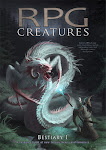This is what the now 146 pages 'RPG-Creatures - Bestiary I' has to offer:
* 9 book exclusive creatures, which I will never post anywhere online, plus the first 45 from the blog, for a total of 54 original creatures.
* 54 full-page color illustrations of the creatures
* A thumbnailed interactive 'Table of Contents', linked directly to the creature images and descriptions, and quick access to the TOC from most pages of the book. (only in the eBook, of course)
* An alphabetical index of the creatures.
* A two-page text of introduction
* A two-page guide to the stats
* A well balanced lay-out and design (for a seriously improved presentation)
* A fine piece of cover art
* Three additional interior color illustrations,
* One piece of b&w collage of creatures (sketches) that never made it to the bestiary. (eBook only)
* One piece of b&w collage of creatures (sketches) that never made it to the bestiary. (eBook only)
* A hundred tiny and sometimes big corrections of language, grammar, and spelling (which now is fully American spelling btw, since that's where the biggest audience is...so far.)
* Many small improvements to, and corrections of, the stats of some creatures.
The eBook is available for $9.50 at RPGNow, where you can also check out a full-size preview. Link!









